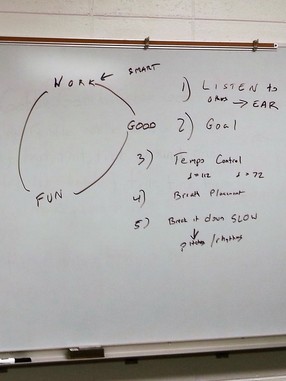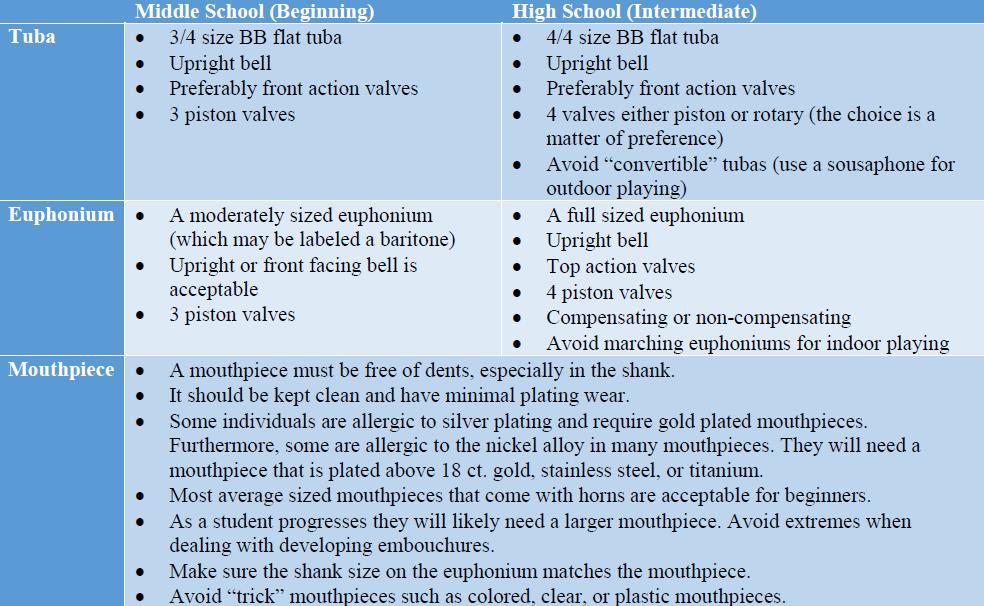|
Dear Friends,
Here is an article I wrote in collaboration with our friends at Classical Singer. I hope it will help students and families as they begin to search for their undergraduate home! Warmest regards, George
0 Comments
Posture and Holding Position - General
Posture and Holding Position - Tuba
Posture and Holding Position - Euphonium
Setting Your Embouchure: YEP-MM-BUZZ!
Starting a Note: SET-BREATHE-TONGUE
LOW NOTES= RELAXED WINDOW FOGGING AIR! HIGH NOTES= FAST, FOCUSED, COFFEE STRAW AIR! Thank you to everyone who participated in our national survey! We are looking forward to presenting its findings in numerous venues and publications, including the Indiana Music Education Association 2019 Professional Development Conference, in the near future.
We will post updates regarding our project on this site. Stay tuned! Beware of “off-brand” or gimmicky instruments. Ask yourself, “why is this instrument less expensive?” It is probably due to cheaper raw materials and a less expensive manufacturing process. Ask your local repairman if they would feel comfortable repairing the instrument. Then determine the next time you or your program will be able to afford a new tuba or euphonium. It will probably be quite a while! If properly maintained and stored this purchase can be with your program for many years so purchase wisely!
Every tuba or euphonium (used or new) should have valves that are freely moving with minimal lubrication, moving slides (all of them), and should be absent of leaks and large dents. It is important to have adequately secured braces. It is acceptable to have lacquer or sliver plating and lacquer is less expensive. It is important that the instrument is ergonomically designed to fit the average size of your students. The student must be able to hold the instrument and maintain proper posture and hand position. Awkward posture or discomfort will inhibit airflow and technique. With tubas this is often evident in the wrapping of the tubing. With euphoniums pay particular attention to the intended left hand placement. Ask a local professional to test an instrument before you make a purchase. My personal criteria is as follows: Is the intonation of the overtone series reasonably consistent? Is the instrument open and free blowing? Is the sound warm and resonant? Is the response consistent in varied registers or dynamic levels? Is it easy to slur or to articulate clearly? Is the instrument easy to play? Dear Friends,
In August I will be starting a new position as the Associate Director of Admissions for the School of Music at DePauw University. I look forward to traveling to meet music educators, prospective students, and their families to tell our DePauw Story! I would like to thank the Marshall University community for their support throughout my tenure with the Marshall University School of Music. I am thankful for our time together and will look forward to hearing about your many success stories in the years to come! GP Dear Friends:
I have added new revisions to my Group Exercises page. The "Brass Warm-Up Routine" is suitable for an intermediate level student and is arranged for Trumpet/TC Euphonium, Horn, Trombone/Euphonium, and Tuba. The Advanced Fundamentals Packet is also available for BC/TC Euphonium and Tuba. If you have any questions or feedback please post a comment below. Happy practicing! GP  Everything we do on the tuba and euphonium is predicated upon a free flowing air stream. I am an advocate of breathing exercises to facilitate tone production and musicality. However, it is worthwhile to consider a few ancillary factors that could impede your air flow. Hear the music. If you don’t have an aural concept of the music you cannot replicate it on your instrument. Listen to recordings. Sing! Control the pitches and rhythm. Have you ever sight-read and found yourself staring at an unfamiliar rhythm? In that moment, was your air freely flowing or was it restricted? The same sensation can be the result of unfamiliarity with pitches and fingerings. How does this impact your ability to employ a free-flowing air stream? Hesitation with rhythms and pitches can lead to hiccups in the air stream and create tension. This is why it is crucial to practice at slow tempi where you can execute the phrase comfortably! Slow practice is an effective way to learn pitches and rhythms. More importantly, slow practice cultivates relaxation and allows the musician to reinforce the proper fundamentals of breath support. Control the tempo. Tempo control is vital in slower and lyrical literature. Find a happy medium where musical expression feels natural. Plan your breaths. Even the obvious ones. Don’t assume. If you breathe too soon it may compound physical tension AND interrupt the musical phrase. And worse yet, you probably didn’t inhale any wind. If you wait too long to breathe, its placement may not coincide with the phrase. In doing so, you probably struggled, gasped for air, and compounded the tension even further. In summary, hear the music, sing, practice slowly, and plan your tempi and phrasing. This will foster relaxation which will in turn allow for an uninterrupted flow of wind. I am pleased to have the privilege of performing at the 2017 Tuba/Euphonium Workshop on February 4th at 12:15 pm. Here are two videos from my performance.
Thank you to everyone associated with "Pershing's Own" for continuing with the wonderful event! Cheers! GP My Daily Routines Survey is now published in the Fall 2016 edition of the Journal for the International Tuba Euphonium Association! UPDATE: results are now posted.
In the meantime I would like to thank Ben Pierce, ITEA Journal Editor, and Scott Lewis, Art Director, for their assistance with the article. Also, thank you to the 187 participants! The project would not have been possible without your contribution. Happy New Year! Georg e Palton It is equally challenging as it is rewarding to perform transcriptions on the tuba. However, there are a few considerations that should be taken into account as you familiarize yourself with the piece. Here are a few:
Download the Solo Tuba TranscriptionRecorded on November 7, 2016 with Mary Beth Norman, piano
|
Archives
October 2021
Categories |


 RSS Feed
RSS Feed